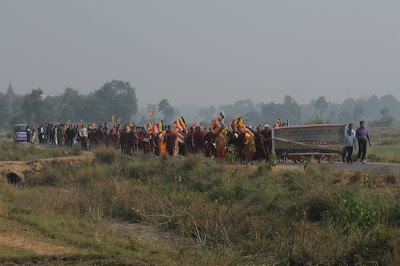Iddhi Samattho Mahā Moggallāna Patha Padakhinā Pada Yātrā
On the occasion of 2497th Anniversary of Parinirvāna of Mahā Moggallāna
20th December, 2010- Mahā Moggallāna Stūpa site, Juafardih, Nalanda
Mahā Moggallāna and sāriputta were born on the same day in neighbouring villages of Rājgriha, both were childhood friends; both joined the Sangha together and their contribution to the Buddha, Dhamma and the Sangha earned the sāriputta title of Dhammasenapati (Marshall of the Dhamma) and the Mahā Moggallāna the bearer of supernormal power (Iddhi & Pātihāriya).
Sāriputta attained Parinirvāna on Kartika Poornimā (Full Moon day- October-November) and Mahā Moggallāna 15days later on Agahana Amāvasyā (New Moon day- November-December) (SA.iii.181). Buddha visited Rajgriha to raise a stūpa over the relics of the Sāriputta. At Rajgriha the Buddha learnt about the Parinirvāna of Mahā Moggallāna. He took Mahā Moggallāna’s relics to raise a stūpa over them too (Cunda Sutta, S.v.161ff, and SN 47.13). Six months later the Buddha attained Mahaparinirvāna on Veshākha Poornima (Full Moon- Veshākha) (SA.iii.181).
As per the corrected chronology year 2010 is the 2494th anniversary year of Parinirvāna of Mahā Moggallāna, the great pillar of the Dhamma. The Department of Buddhist Studies, Nava Nalanda Mahavihara in continuation to its efforts to generate awareness and revive the ancient Buddhist pilgrimage is organising “Mahā Moggallāna Patha Padakhinā Pada Yātrā”, at the Mahā Moggallāna stūpa site at Village Juafardih. The objective of the Padakhinā Pada Yātrā is to pay homage to this great Pillar of Dhamma, to create awareness among the community regarding the rich heritage of Nalanda and revive the ancient Buddhist pilgrimage sites of Nalanda.
Stūpa Site at Juafardih
The Pali sources maintain Kolitagāma; the village of Mahā Moggallāna was near Upatissagāma (Village of Sāriputta) and not far from Rajgriha (SNA.i.326; DhA.i.73; Mtu.iii.56).
 |
| The Stupa before excavation |
 |
| Children at the stupa |
 |
| Excavation in progress in 2007 |
 |
| Stupa from a distance |
 |
| Xuanzang says the stupa was made to mark birth and the death of Maha Moggallana |
 |
| Stupa has many successive reconstruction in different periods |
 |
| Shri Sujit Nayan from Archaeological survey of India, who participated in Stupa Excavation in 2007 |
 |
| Large quantity of Pottery Collected from the stupa site |
 |
| Ancient Pottery found at Juafardih |
 |
| The Beautiful Ambiance of Juafardih (ancient Kulika) |
 |
| Community of Juafardih participating in uncovering their heritage |
 |
| The Brick Encasing - Xuanzang saw a Brick Stupa at Kulika |
Celebrated Monk scholar Xuanzang, who came to Nalanda in the 7th century CE, visited the Ashokan stūpa to mark birth and death of Mahā Moggallāna at the Village Kulika (Travels¹, Thomas watters, Vol-2, P-171). Kulika, Xuanzang maintains was a part of Nalanda Sangharama, he briefly stayed at a farm house here (Life²- S. Beal, P- 109).
Xuanzang maintains that the stūpa site was 8-9 Li South-West of Nalanda Sangharama (Travels¹, Thomas watters, Vol-2, P-171) and 7 Yojans from the Bodhi Tree (Life²- S. Beal, P- 108). Based on the description provided by Xuanzang and some research studies done in the past the Archaeological Survey of India in 2007 conducted excavation of the 10 Mt high mound measuring 105 X 100 Mt. The excavation revealed the mound to be a Stūpa site from the times of the Buddha with successive reconstructions in later periods. Among the rich antiquities unearthed in the course of excavation was a broken disc bearing two Brahmi letters “MUGA” (Excavation at Juafardih and its identification with Kulika, Puratattva-vol- 38). All the finds suggests this stūpa to be the stūpa to mark birth and death of Mahā Moggallāna as mentioned by Xuanzang
 |
| The Custodians of the rich legacy |
 |
| Beautiful Sunset at the Village of Maha Moggallana |


















































